March 23, 2020
 by Andriy Zapisotskyi / March 23, 2020
by Andriy Zapisotskyi / March 23, 2020

Although the bright side of email marketing is all about making sure that the message stays in the reader’s mind, there’s a lot going on underneath.
There are dozens of moving parts responsible for email delivery: servers, domain name systems, IP addresses, and others. All of these are known collectively as email infrastructure.
As a rule of thumb, marketing teams don’t set the infrastructure up on their own, leaving the technicalities to the IT department. Having said that, whether you are a marketing manager or a business owner, an understanding of how all the wheels of the infrastructure machine work together will help you get insight into the campaign’s performance.
Email infrastructure is a system built to fuel the delivery of all newsletters or transactional emails you send out. It typically consists of the following components: IP addresses, mail agents, feedback loops, and email reputation management tools.
IP addresses are strings of numbers that the domain system name (DNS) attaches to domains. Thanks to these, we can use letters (google.com and such) instead of numbers (256.58.217.06) to visit websites.

Whenever you type ‘google.com,’ DNS processes it to connect you to the IP
There are two types of IP addresses you can attach your domain to: a dedicated and a shared one.
In email marketing, IPs are a huge part of a sender’s reputation. A hosting provider traces all the actions a business owner takes back to the IP and assigns a reputation score based on these. If you share an IP with other websites, chances are, they are not as diligent in following email marketing practices as you are. And since you share an address, you will go down together.
Having no control over IP reputation can damage email deliverability rates of your campaigns, which is why using a dedicated IP for bulk email marketing campaigns is recommended.
A mail agent is a tool that helps view, reply to, or transfer emails between a sender and a recipient. A typical email infrastructure uses several mail agents on different stages of an email’s journey.

The journey of an email from the sender’s to the recipient’s inbox
An SMTP server is an application that a chosen email client uses to exchange emails between users. Every ark dedicated server provider has a different SMTP address - the general look is: smtp.serveraddress.com
For example, Gmail’s SMTP is smtp.gmail.com, Outlook’s is smtp.outlook.com, and so on.
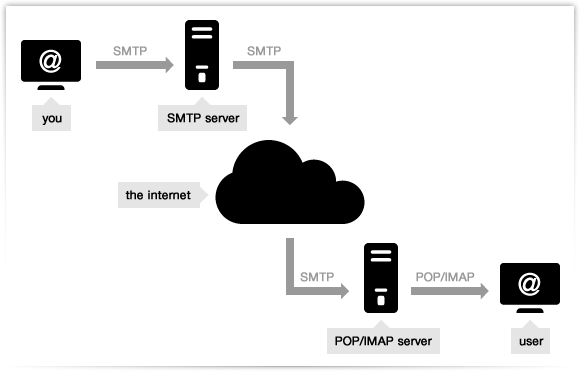
SMTP servers are repeatedly accessed during the email delivery process
What is the purpose of an SMTP server? In a nutshell, it processes email data and passes it over to the recipient’s inbox, validating a few conditions in the process:
If a reader uses an anti-spam filter, this is another reason why the SMTP server might fail to deliver the email to the target inbox as well.
A feedback loop (FBL) is one of the key processes empowered by email infrastructure. If a campaign sender sets up a feedback loop, he will be able to find out how the reader interacted with an email. This way, marketing teams can remove poorly engaged subscribers from the list to make sure the content is fully relevant to the audience.
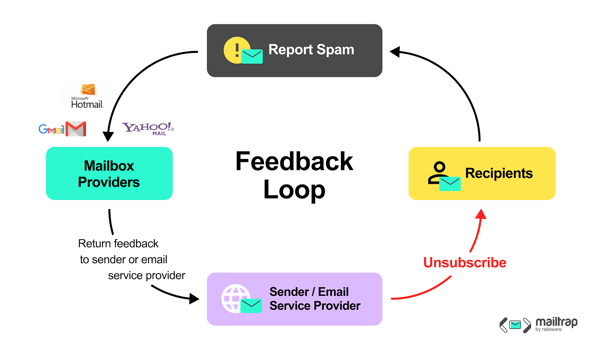
A visual breakdown of an email feedback loop
To register for an FBL, a business owner needs to meet a set of conditions:
Monitor feedback loops frequently to assess the relevance of the content you share with subscribers and keep the subscriber list clean.
To have a stronger contact with email audiences, marketing teams add business intelligence and analytics tools to the infrastructure. These solutions help keep tabs on the conversions and open rates of your emails, automate campaign management, track KPIs, and give you confidence in the campaign’s performance.
Marketers usually use email reputation management tools to achieve these goals:
Handling your email user base might be a breeze when there aren’t more than a few hundred people on the subscriber list. However, as the number of readers grows, keeping a stellar reputation and staying responsive becomes considerably harder.
That’s why, at some point, email marketers and the development team need to review the existing architecture with scalability needs in mind. To make sure your email marketing backbone can handle expansion challenges, follow these tried-and-true tips.
It’s common for marketers to emphasize the importance of personalization. We all want to make customers feel they are important to us and try to avoid generic copy as much as possible.
However, if you analyze your company’s ‘Sent mail’ tab, most likely, there will be a lot of repetitive replies. To make sure you don’t have to type ‘Sorry, I’m unavailable right now’ in manually, save your time by pre-designing templates to the most common conversations with clients. You can also leverage automated email responses to ensure your replies are sent on time and without any hassle. Here are some ideas.
Sometimes, a client asks an in-depth question you can’t answer without giving the team a heads-up. Chances are, you get outreach emails on weekends or vacations as well. Here’s how you can use a canned reply to ensure you are not missing out on prospective leads.
Hi [Name],
Thanks for reaching out about [topic name]. For now, I am going to look into it and get back to you with a detailed answer by Friday. Let me know if this is alright with you!
Best,
[Your Name]
This template will help you deal with criticism without putting the company’s reputation at risk.
Hi [Name],
I appreciate your feedback and was interested to hear about your point of view. I can see what made you feel this way and would love to make the inconvenience up to you.
I hope we can discuss the [topic name] over a call or a meeting? Let me know which one works better for you. I believe we can work things out and continue the collaboration.
Take care,
[Your Name]
At times, we all get offers that are impossible to take. However, the inability to contribute to the project doesn’t always mean you should cut ties with the one who offered the opportunity. Instead, you can design a polite and efficient reply to stay in touch and make sure the person on the other side of the email has no hard feelings.
Hi [Name],
Thanks for reaching out to me with the offer. I would be happy to get onboard - however, I don’t have enough time to commit to new projects. I would be happy to share the contact of a professional who handles this type of project as well.
Would this help you in any way?
Regards,
[Your Name]
Create five to seven pre-planned templates and use them to deal with repetitive emails in a matter of minutes. Be extra careful to insert dynamic data instead of [name] or [topic] tags. Leaving them in is a common mistake and is considered a mauvais-tone in email communication.
With the proliferation of chatbots, more businesses are jumping on the ‘Lead generation forms are dead’ bandwagon. However, it might just be too soon to jump to such sweeping conclusions.
In fact, 49.7% of people named email lead forms as the highest-converting marketing tools. Surprisingly, multi-step capture forms proved to be more efficient than one-step ones.
To improve email marketing efficiency, focus on capturing more users via an on-site signup form. Business owners remark that sharing free lead magnets - eBooks, checklists, and others – is one of the most efficient ways to gather user data and connect with prospective leads.
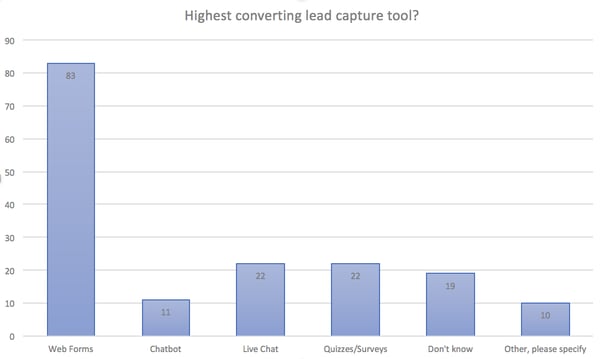
According to HubSpot, web forms are still the highest-converting lead capture tool
Email marketing is not an instant remedy for low user engagement – getting a steady open rate and CTRs may take weeks. Because of its long-haul nature, running email marketing campaigns requires incredible consistency.
Instead of sending emails every other day on a sporadic basis, schedule all emails for a set day and time. Here’s how email marketing consistency will help make the most out of a low-budget email infrastructure:
The more emails you send, the more mistakes you can make. Especially when it comes to transactional emails. First off, protect your customers/subscribers from your test emails. Isolate your testing environment from production, a real one. Use complex email testing solutions to test your scripts, message content, and deliverability, keeping your testing data well-organized in one place. Below is what and how you can test in general.
Verifying email content is quite obvious, but don’t forget about the “from” address, subject line, and pre-header. Make sure that links work properly and images are displayed across different email clients. For this purpose, you can use the capabilities of your email marketing software and also the third-party tools.
If you use any kind of dynamic content (like recipient’s name), verify that mail merge really works. Your email marketing provider should take care of the mail merge and scripts, and your responsibility is keep your database correct.
When sending transactional emails with the combination of tools and your infrastructure, it is recommended to run thorough tests for the whole database. The easiest way is to utilize an email testing API so that you can run automated tests.
Your task here is to make sure that your message don’t land in the spam folder. You can make manual checks or use a dedicated tool to help you.
The reason why email marketing campaigns fail is often that the marketing team sees every letter as a one-off, not a part of the bigger picture. As you design a strategy for connecting with subscribers, keep in mind that a single email is not enough to encourage subscribers to make a buying decision.
Using email automation software helps business owners save type, know the audience better, and offer readers the content they never knew they needed. Here’s how automation tools improve the efficiency of your campaigns.
Email automation tools empower campaigns with individualized offers, help group people by interests and share content that resonates with every reader on a personal reason. This way, a business owner stands a higher chance of connecting with the audience, as 90% of consumers value personalization in transactional emails.
The same data showed 59% of marketers acknowledged that automation would help save as much as six hours per workday. Your team can re-allocate this time to discovering new promotion channels or improving the core product of the business.
Sending a hundred emails manually might not seem like too much of a burden. However, as the subscriber list expands to thousands of readers, accommodating such a large user base will be increasingly more challenging. Most scalability tools are capable of handling sudden audience spikes, even if the number of subscribers was to triple overnight, the marketing team will have all the tools needed to retain new readers.
Be it malware, phishing attacks, or other types of threats, a fair share of email security risks are server-based. That’s why building the email’s line of defense starts with securing SMTP and other servers.
Here are the tips you can follow to avoid third-party attacks:
We work hard to get new email subscribers; naturally, we want to retain them for as long as possible. So, you can find marketers going as far as to hide the ‘Unsubscribe’ button or remove it altogether.
Long story short, this is not the right approach for long-term email marketing success. For one thing, according to the FTC’s CAN-SPAM act, a sender has to provide users a way to stop getting future emails. For non-compliance with the guidelines, you can be fined for up to $41,484.
Even if the government doesn’t fine you, the reputation of your address is likely to take a toll if you keep sending messages to uninterested readers. Instead of unsubscribing, an irritated user will flag the message as spam, increasing your odds at ending up in the blacklist.
At the end of the day, letting unengaged users go is in your best interest. Here’s how you can facilitate opt-out without drawing too much attention to the ‘Unsubscribe’ button.
If a user doesn’t like some of the content you share, it’s not a given he doesn’t want to hear from you altogether. Rather than cutting the ties with a reader completely, give him a chance to reconsider the terms of the subscription.
Here’s how Bonobos does it:
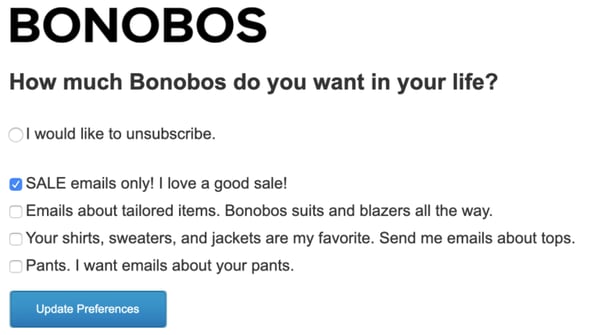
When users choose the type of content they are interested in, it’s easier for marketers to keep readers happy and engaged.
Even if a user wants to part ways with you, make sure you make the most out of the time spent together. For one, find out why a reader no longer wants to get content from the company. Offer a list of most likely opt-out reasons or encourage people to list their own.
This data will come in handy when planning future campaigns; the marketing team will know what went wrong the last time and will prepare for a better outcome.
Here’s an example of letting a user off the hook with a short follow-up survey:
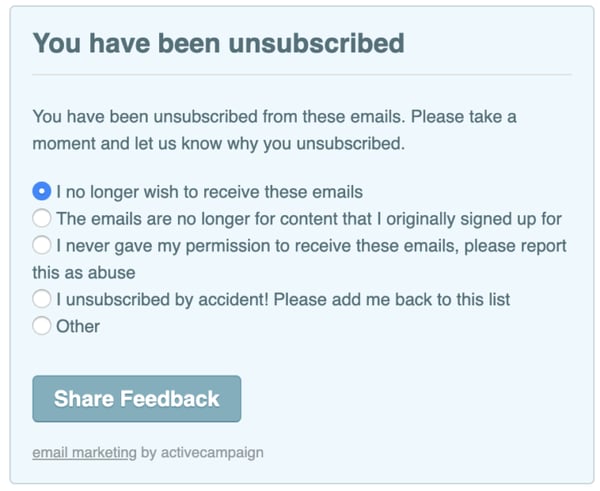
Opt-out feedback surveys are a valuable source of insight for email marketing campaign planning
It’s not enough to put ‘Unsubscribe’ in plain sight - you need to make sure the target page meets webpage security guidelines (such as using the HTTPS protocol) and is not broken or infected with malware. Otherwise, a user will get a system warning and will not be able to complete the opt-out successfully.
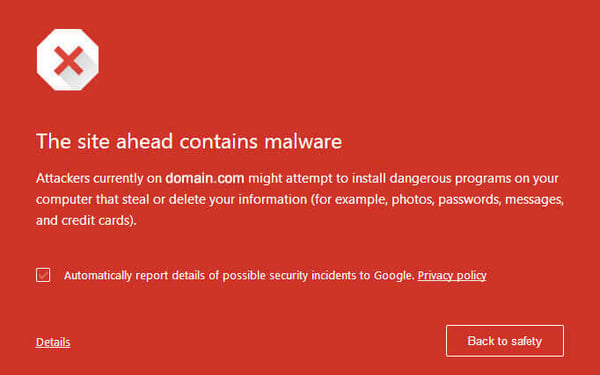
If an opt-out page is infected with malware, there’s no way for users to remove themselves from the subscriber list
When you think about scalability, acquiring new users becomes the top priority. However, a surer path to an engaged and converting audience is to leverage upon existing readers, not rushing to get new ones.
You are 10 times as likely to sell a product to an existing customer than to a newly acquired lead. While marketers should focus on spreading the word of the newsletter, it’s just as important to analyze the behavior of engaged readers and ensure they enjoy interactions with the brand. Let's explore how you can improve their experience.
Similarly to how a good house needs to have a good foundation, successful email campaigns have to be based on a secure, robust infrastructure. It’s helpful for business owners and email marketers to follow best industry practices, such as ensuring the safety of your servers and IP address or using automation tools to oversee campaigns.
This way, you will avoid reputation risks and protect the email from getting blacklisted. Keep in mind that initially steering clear of spam filters is many times easier than finding your way back up. Be mindful of the content you share with users, track their responses, and use collected insights to adjust campaign strategies.
Use dedicated email testing tools and all appropriate software to support data collection and decision-making, and you'll be one step closer to a #NoFailMail.
Andriy is a Growth Manager at Mailtrap, a product that helps inspect and debug emails before sending them to real users. He has over 5 years of experience in the field of marketing and product. Andriy loves to network with people, so connect with him on LinkedIn!
The more a business relies on information technology (IT), the more important it is to have a...
 by Keerthi Rangan
by Keerthi Rangan
When someone asks what type of “shop” your organization is, can you answer confidently that...
 by Hannah Culver
by Hannah Culver
CoreWeave's IPO has finally hit the market, and Wall Street's reaction has been muted as...
 by Holly Hunt
by Holly Hunt
The more a business relies on information technology (IT), the more important it is to have a...
 by Keerthi Rangan
by Keerthi Rangan
When someone asks what type of “shop” your organization is, can you answer confidently that...
 by Hannah Culver
by Hannah Culver


